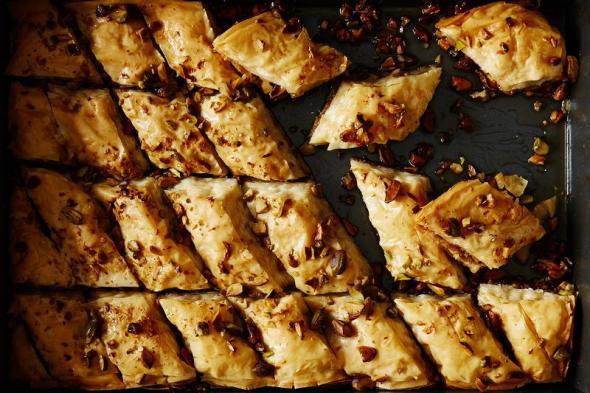This post originally appeared on Food52.
The most fascinating thing about baklava—to me at least—is just how different a bite of baklava can taste across different Middle Eastern borders. I’ve had an Ethiopian slice scented with coffee and walnuts, an Armenian iteration chock-full of cinnamon and cloves, and a syrupy sweet square from the Levant.
My own taste buds gravitate towards those of the Persian variety, which are lighter and less sweet than their counterparts consumed in the Levant or Maghreb, and whose rosewater and cardamom notes never fail to remind me of my family’s home in Iran.
I find that baklava is best made in a cozy kitchen, with a drink in hand and a friend by your side. It can’t be rushed, simplified, or made less messy. While baking is oftentimes considered a science, baking baklava is more like art. It’s a process unmarred by fancy utensils or tools—you need little more than your hands and a paintbrush. While some recipes call for a thermometer or a toothpick, really all you need are your fingertips to judge how the baklava are coming along.
Here’s how to make baklava, any way you want:
1) Gather ingredients.
Start with one store-bought roll of phyllo dough, 2 sticks of unsalted or salted butter (cook’s choice!), and nuts.
While the dough is thawing (frozen dough should thaw for at least 2 hours at room temperature, and this step cannot be skipped, lest it crack and splinter), smash your nuts coarsely. I reach for one of the copious bags of salted pistachios that live in my refrigerator, by way of Iran, but you can opt for walnuts, almonds, or a nut of any kind—salted or unsalted, toasted or untoasted. Take the party to your food processor, or work out some aggression and smash them lightly with a hammer.
Add 1 part sugar for 4 parts nuts. Then mix in spices: If it’s a Persian flavor you crave, add cardamom here, or for a Levantine variety, opt for cinnamon. Those in need of a morning boost can even add fine coffee grounds to taste.
2) Start layering.
Preheat the oven to 350° F and prep your baking pan. You’ll want it to have a small rim around the edges, and it’s best if you cut the sheets of phyllo to fit snugly and evenly in the pan.
Melt your butter, and ready your pastry or paint brush; lay your first phyllo sheet down on a baking pan or sheet, and brush with melted butter. Repeat, gingerly buttering each sheet, until you have a nice stack of dough—2, 3, 4, or even 5 centimeters high.
Gently spread your nut mixture evenly across the buttered phyllo layers, smoothing and patting with your hands to distribute evenly. Top with another layer of phyllo, followed by a coat of melted butter, and continue to paint and stack the dough until you run out.
3) Cut pretty pieces.
Here comes the challenge: Take a knife and gently slice across the dough diagonally. The top layer of phyllo dough may fidget and stick to your hands, but it’s nothing patience and a sharp blade can’t handle. Slice the dough once more vertically so you have diamond shapes. I like mine about 1 by 2 inches, but play with the dimensions of your baklava as you see fit.
Top with crushed pistachios or nut slivers if you please, and send your baklava off the oven to bake for about an hour, until the puff pastry puffs and browns lightly around the edges. It should look crispy and maybe slightly flaky, and the buttery, nutty smell will warm your kitchen.
4) Make syrup.
While your baklava is baking, make the sugar syrup that’s used to soak them when they’re still hot from the oven. To me, pouring dense syrup or honey over baklava is sacrilege—it makes it syrupy and saccharine instead of fragrant and light. Instead, I opt for a lighter simple syrup: Mix together 1 part sugar to 1 part water (I usually use a cup of each) in a saucepan, bring to a boil, then reduce the heat to a simmer and cook until you have a light syrup.
I sweeten mine with 1/4 cup of rosewater, a teaspoon of tart pomegranate molasses, and the juice of half a Meyer lemon. You could add orange blossom water, cinnamon, cardamom pods, anise, a splash of tea, or whatever else makes your stomach rumble. Let the syrup sit for a while, until it’s room temperature.
As soon as you pull the baklava out of the oven, pour your syrup over it, making sure it gets in the crevices and tops every square. Let sit for at least 8 hours or overnight. In the morning, you can expect an abundance of baklava, the perfect companion to your morning coffee or tea.
More from Food52:
How to Stock a Fridge & Freezer for One
4 Chicken Dinners You Can Turn into Lunch
10 Ways to Make Your Favorite Chili Recipe Even Better
How to Make Any Quesadilla Better
12 Perfectly Acceptable (and Wonderful) Ways to Make Eggs for Dinner
Get Cinnamon Sugar Pretzel Bites Without a Trip to the Mall
